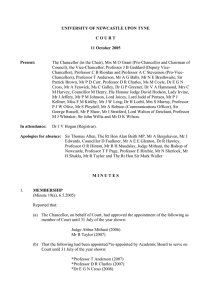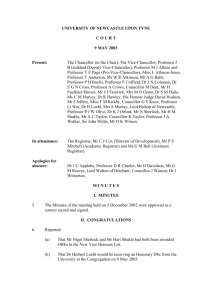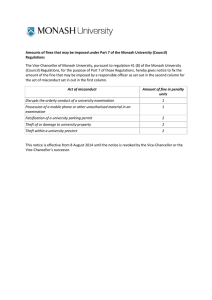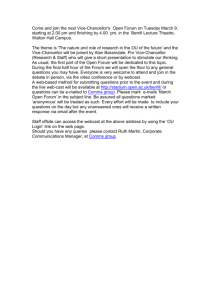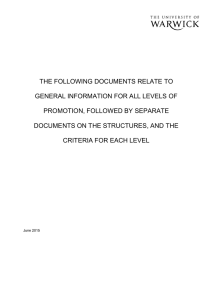NEWCASTLE UNIVERSITY C O U R T 10 October 2006
advertisement
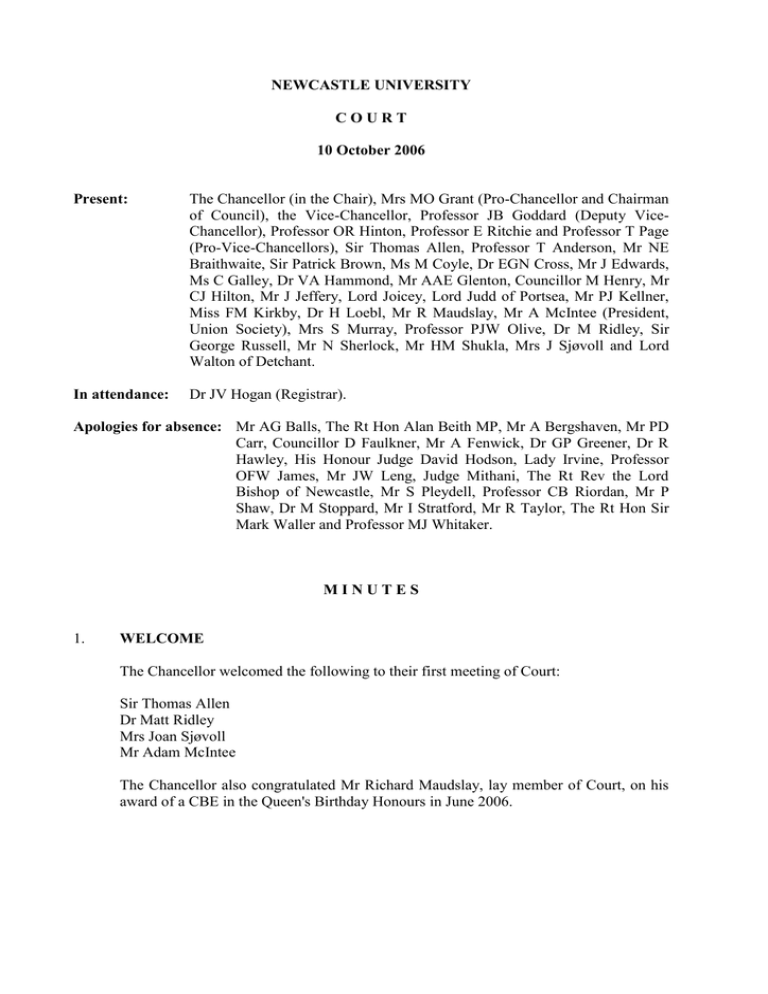
NEWCASTLE UNIVERSITY COURT 10 October 2006 Present: The Chancellor (in the Chair), Mrs MO Grant (Pro-Chancellor and Chairman of Council), the Vice-Chancellor, Professor JB Goddard (Deputy ViceChancellor), Professor OR Hinton, Professor E Ritchie and Professor T Page (Pro-Vice-Chancellors), Sir Thomas Allen, Professor T Anderson, Mr NE Braithwaite, Sir Patrick Brown, Ms M Coyle, Dr EGN Cross, Mr J Edwards, Ms C Galley, Dr VA Hammond, Mr AAE Glenton, Councillor M Henry, Mr CJ Hilton, Mr J Jeffery, Lord Joicey, Lord Judd of Portsea, Mr PJ Kellner, Miss FM Kirkby, Dr H Loebl, Mr R Maudslay, Mr A McIntee (President, Union Society), Mrs S Murray, Professor PJW Olive, Dr M Ridley, Sir George Russell, Mr N Sherlock, Mr HM Shukla, Mrs J Sjøvoll and Lord Walton of Detchant. In attendance: Dr JV Hogan (Registrar). Apologies for absence: Mr AG Balls, The Rt Hon Alan Beith MP, Mr A Bergshaven, Mr PD Carr, Councillor D Faulkner, Mr A Fenwick, Dr GP Greener, Dr R Hawley, His Honour Judge David Hodson, Lady Irvine, Professor OFW James, Mr JW Leng, Judge Mithani, The Rt Rev the Lord Bishop of Newcastle, Mr S Pleydell, Professor CB Riordan, Mr P Shaw, Dr M Stoppard, Mr I Stratford, Mr R Taylor, The Rt Hon Sir Mark Waller and Professor MJ Whitaker. MINUTES 1. WELCOME The Chancellor welcomed the following to their first meeting of Court: Sir Thomas Allen Dr Matt Ridley Mrs Joan Sjøvoll Mr Adam McIntee The Chancellor also congratulated Mr Richard Maudslay, lay member of Court, on his award of a CBE in the Queen's Birthday Honours in June 2006. 2. MEMBERSHIP Reported that the Chancellor, on behalf of Court, had approved a recommendation from Court Steering Committee that Mrs Joan Sjøvoll (Headteacher of Framwellgate School Durham) be appointed as a lay member of Court with immediate effect until 31 July 2009. 3. MINUTES Approved the Minutes of the meeting held on 5 May 2006. 4. APPOINTMENT OF NEW VICE-CHANCELLOR Received an oral report from the Chairman of Council. Noted that: JVH/js 1. Professor Edwards had indicated his intention to retire in 2007. 2. Following the procedures set out in the University Statutes, a joint committee of Senate and Council have been appointed, chaired by the Chairman of Council. 3. A firm of executive search consultants was appointed to help. 4. As part of the process in drawing up the job description, widespread consultation took place both within the University and with some of our key external partners, including the RDA and the City. 5. The executive search consultants reported that there was a lot of interest in the position at Newcastle and they had received some very positive comments about the way the University had developed. 6. The University followed various good practice guidance that had been issued by the Universities UK and others on the appointment of new vice-chancellors. 7. Sir Martin Harris, former Vice-Chancellor of the University of Manchester, had been appointed as the external advisor to the committee and had been very helpful in his input. 8. The committee had considered an initial list of 17 candidates and eventually interviewed 4 people over a two day period. All the interview candidates had had the opportunity to visit the University in advance. 9. The decision-making process had been a difficult one since the committee had been presented with 4 excellent candidates. In the end it made a recommendation to Senate and Council to appoint Professor Chris Brink, currently Vice-Chancellor of Stellenbosch University in South Africa. Council had agreed to Professor Brink taking up his appointment as the new ViceChancellor on 1 August 2007. 2 10. There would opportunity to thank Professor Edwards for his contribution as Vice-Chancellor and it is very noticeable that the way in which a number of the external parties consulted had expressed a desire for the incoming ViceChancellor to continue building on the work and specifically the links with the community that Professor Edwards had initiated. 11. In the past, Court itself had had a role in the appointment process but this had been changed as part of the change to the Statutes to reflect the position of Council as the University's governing body. 12. Professor Brink would be making a brief visit to the University later in October and would probably do so again in January 2007. 13. The Chairman had had an opportunity to visit Stellenbosch University recently where she had met senior members of staff including the Chairman of the governing body. Professor Brink had led an important campaign on the use of English language in the University. He had undertaken his PhD at Cambridge University and had worked for a period of time in Australia. Resolved that Court congratulated Professor Brink on his appointment and looked forward to welcoming him as the University's new Vice-Chancellor in August 2007. 5. VICE-CHANCELLOR'S BUSINESS: TIMING OF VISITS FOR MEMBERS OF COURT Agreed that it would be helpful if the timing of the programme of visits for members of Court could be scheduled for the early afternoon of the meeting of Court rather than the preceding afternoon which was currently the case. It was felt that this would facilitate a greater proportion of members of Court having an opportunity to participate in the visits programme. 6. STRATEGIC PLAN Received an oral report from the Vice-Chancellor on the University's Strategic Plan. Noted that: JVH/js 1. Council, at its meeting held in July 2006, had approved the new corporate plan. 2. The Vice-Chancellor made a presentation based on aspects of the new corporate plan and a copy of the presentation is attached to these Minutes. Appendix A 3. There appeared to be a correlation between increasing the number of staff in medicine and science and increasing the University's overall income. This was one of the reasons why the University had a particular interest in the Science City initiative. 3 JVH/js 4. On the evidence of the intake in 2006, top-up fees had not deterred UK undergraduates from studying at Newcastle. However, there was concern about the implications of top-up fees on the willingness of UK students to stay on for postgraduate study and this was something that would need to be kept under careful review by this and other universities. 5. The Vice-Chancellor was concerned that it appeared that we would be down on the number of new overseas undergraduate students. It was in order to improve the University's performance in the recruitment of international undergraduate students that the University was contemplating entering into a partnership with INTO to establish a foundation course for entry to the University. 6. Approximately 23% of the University's undergraduates came from the North East. The University made a heavy commitment to widening participation and its flagship programme, PARTNERS, had been responsible for much of the increase in applications from local schools in recent years. 7. The University was disappointed with some of the results from the National Students Survey. Whilst certain aspects of the survey could be criticised in terms of methodology and comparisons between institutions, there was no doubt that the survey presented some useful management information internally and issues had been raised and would be addressed concerning the comparative performance of various subjects. 8. The University had been successful in European funding, particularly Framework 6, but the low level of overheads associated with this income source created some difficulties. 9. Other aspects of the University's international policy included the possible development of a medical campus in Malaysia and the continuing initiative to use Singapore as a base from which to exploit our intellectual property. 10. The University had over 100,000 members of the alumni and was improving its efforts to keep the alumni engaged with activities in the University. 11. The University was expecting its turnover to exceed the £300m mark for the first time during 2006/07. 12. The 2007 Research Assessment Exercise results would be presented in December 2008 and the funding associated with the results would be changed for the 2009/10 financial year. 13. With regard to the Science City project, the Treasury had indicated that it would expect the Regional Development Agency to use existing funds available to it to support this project. The RDA was firmly committed towards Science City and this included financial support. The RDA had already made commitments to a series of projects and when a joint vehicle was established to manage the Science City project there would be an expectation of increased levels of funding from private and public sectors. 4 JVH/js 14. The initiative at Singapore focused on translational research. The University had control of a lot of intellectual property but it was important to display this property in an appropriate fashion to allow potential investors to invest in particular opportunities. 15. The number of medical students trained by the University had increased in recent years and this gave some basis for an increase in the staff which in turn should lead to a greater share of the research income for medicine coming to this University. 16. A joint initiative was being prepared with Durham for a bid for additional student numbers in Biosciences and Biophysics. 17. There was general anticipation that the next comprehensive spending review would be difficult for higher education and this in turn might put some pressure on the government to lift the current cap of £3,000 on undergraduate tuition fees when this was reviewed in 2009. 18. There were now many league tables in operation and in some the University's position was disappointing. In a recent world league table published in the Times Higher Education Supplement the University's position had improved significantly from 168th place in 2005 to 133rd in 2006. However, with all these league tables the range of factors taken into account and the somewhat arbitrary methodology used could lead to certain distortions. 19. An issue was raised concerning fundraising from the alumni. The University was still attempting to build up its contacts with the alumni and overall funding remained modest. Within this there had been more success with the telephone campaign directed towards financial support for students. A particular area of concern highlighted in the national student survey was the nature and speed of feedback on student assessment. Generally throughout the sector, higher education institutions had performed relatively poorly in responses to this question on the survey. 20. The University had responded to certain indicators including league tables by reexamining its own internal performance practice, such as employability and the percentage of first class degrees awarded. These did raise important issues for the institution. 21. Probably it was much easier for the University to address the issues raised in the national league tables, which in the main used data published by the Higher Education Statistics Agency, than data obtained from peer review in the world league tables which was more subjective. 22. There could be some tension between undertaking research which had a clear commercial potential and highly original fundamental research. Whilst this potential tension was recognised, it was also felt possible to reconcile these two approaches within an appropriate research climate. 5 JVH/js 23. The competition for international students appeared to be set to become more competitive with an increased number of institutions in Europe offering postgraduate programmes in English. The University intended to maintain an interest in developing links with Cumbria and did not regard the forthcoming establishment of the University of Cumbria as creating any additional obstacles in this regard. 24. The University had a major commitment to work that supported the developing world. In January it would hold a special degree ceremony to recognise the campaign for Making Poverty History. At this special degree ceremony a number of key figures in the campaign would be honoured and more information would be provided to members of Court about this event shortly. We would also use the event to display our research linked to the developing world and a briefing document was attached to these Minutes. Appendix B 25. The promotion of the University was closely associated with the promotion of the City. This raised some issues about the branding of the City and whether it was entirely appropriate for a very diverse international community. It was felt that the campaign relating to the European City of Culture had been positive and had established a good basis for the marketing of both the University and the City. 26. Whilst approximately 23% of our undergraduates came from the North East, approximately 56% of our graduates obtained initial employment in the North East after graduation. This seemed to show that the University was a net importer of graduates to the region, although further information on the extent to which the 56% subsumed the 23% was not available. 27. It was recognised that the recruitment of students depended in part on the perception of job prospects after the degree and this was another aspect of the Science City project, trying to raise the number of graduate vacancies in the North East. 28. Framwellgate School Durham hosts the regional science learning centre and working under the leadership of Joan Sjøvoll, Headteacher, the centre has been important in developing the Newcastle Science City Integrated Education Strategy for the region. 29. The University's work in employability was well supported by the Careers Service. 30. The issue of the comparatively small proportion of first class honours degrees awarded raises certain difficulties. It might be possible to present this as an advantage and emphasise the value of the Newcastle degree. 31. The Burgess Group, chaired by the Vice-Chancellor of the University of Leicester, was consulting the sector on the abolition of the current degree classification scheme and its replacement with a grade point average system or something similar. 6 7. 32. There had been historically some reluctance by those obtaining first class honours degrees to enter industry. 33. The University continued to attract entrants from mature students although its previous lifelong learning activity had not been directed at providing educational opportunities to those who had not previously enjoyed such opportunities. 35. In order to develop University's research profile it intended to continue to exploit areas of excellence such as stem cells. ANY OTHER BUSINESS Invitation to members of Court to submit items for the Agenda. Noted that Dr Loebl raised the issue of giving members of Court the opportunity to present items for the agenda of Court. Resolved that members of Court should be invited to submit items to future meetings of Court with a deadline of 2 weeks before the scheduled meeting. For the meetings to be held in 2007 therefore, the deadline for the meeting to be held on 20 April 2007 would be 6 April 2007 and the deadline for the meeting to be held on 23 October 2007 would be 9 October 2007. 8. DATES OF FUTURE MEETINGS Reported: JVH/js (i) That the next meeting of Court would be held at 10.30am on Friday, 20 April 2007. (ii) That the following meeting would be held at 10.30am on 23 October 2007 and would be preceded the evening before by the Honorary Fellowships Dinner. 7
